The maintenance and care of titration electrodes includes proper storage, refilling with the correct electrolyte and, if necessary, cleaning the electrode.
Which solution do I use to refill and store the electrode?
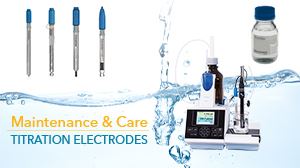 The maintenance and care of an electrode are decisively influenced by its type. An electrode with liquid electrolyte must also be topped up, otherwise sample solution can be pressed into the electrode if the electrolyte level is too low. In extreme cases, this can poison the electrode's reference system and render it unusable.
The maintenance and care of an electrode are decisively influenced by its type. An electrode with liquid electrolyte must also be topped up, otherwise sample solution can be pressed into the electrode if the electrolyte level is too low. In extreme cases, this can poison the electrode's reference system and render it unusable.
The electrolyte depends on the type of electrode. For pH and redox combination electrodes, this is a KCl solution with a concentration of 3 mol/L. For silver combination electrodes, a KNO3 solution 2 mol/L with a small addition of 0.001 mol/L KCl. For pH electrodes for non-aqueous titrations, the electrolyte solution consists of either LiCl/ethanol or LiCl/glacial acetic acid 1.5 mol/L.
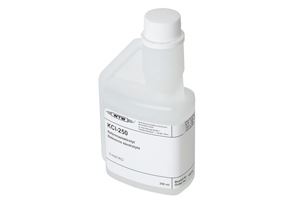
Fig. 1: electrolyte solution KCI-250
With a low-maintenance electrode with gel electrolyte or an electrode with pH glass as a "reference system" (AgCl 62 RG, Pt 62 RG etc.) and with measuring electrodes, refilling is not necessary.
The electrolyte solutions can also always be used as a storage solution. You can also use distilled water for the RG electrodes.
For pH electrodes, there is also a special storage solution L 9114, in which something is added to the KCl electrolyte.
How to clean the titration electrode?
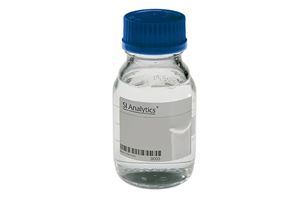
Fig. 2: hydrochloric acid pepsin solution L 5104
All electrodes with glass and metal sensor can be cleaned according to the following scheme:
- Carefully wipe off deposits on the glass membrane with a damp cloth.
- Rinse grease/oil with alcohol or water containing detergent.
- Remove proteins with hydrochloric acid pepsin solution L 5104. Always rinse with distilled water afterwards. Diluted hydrochloric acid (e.g. HCl 1 mol/L) can also be used as an alternative to the hydrochloric acid pepsin solution.
The following instructions for individual electrodes must be observed:
- Never wipe electrodes with platinum diaphragms with a cloth. Only ever rinse with a solution.
- Blank silver and platinum electrodes with a pin sensor such as Ag 62 IDS, Ag 6280, Pt 62 or Pt 62 and all double platinum electrodes such as KF 1100, KF 1150 and Pt 1200 can also be cleaned with an abrasive agent. Always rinse with distilled water afterwards.
Storage and cleaning of ISE:
ISE should always be stored dry.
Only clean the electrodes with PVC membrane such as TEN 1100 and Ca 1100 PLH with an aqueous (max. 5 % alcohol) solution. Never clean electrodes with PVC membrane with an alcoholic solution.
Further information can be found in the titration catalog
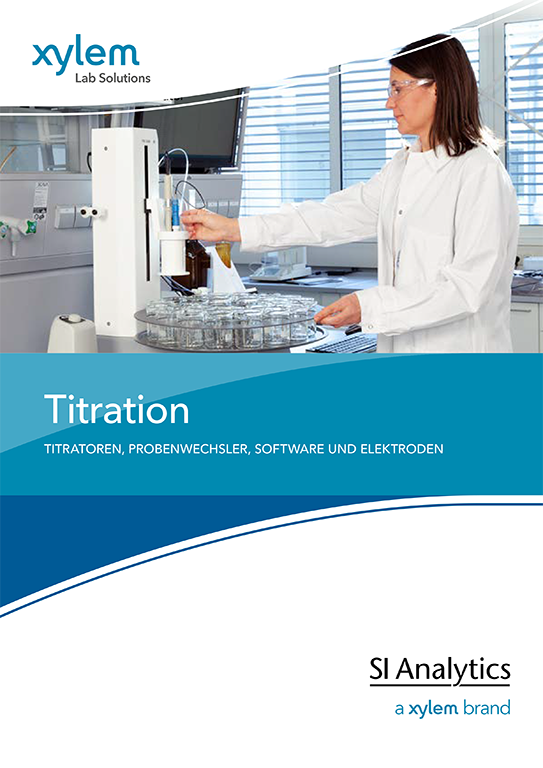
Find here all components for a manual or automated titration with our high-precision software Titri Soft 3.5 for your use in the laboratory. Learn more about all products in the laboratory environment: coulometric and volumetric titrators, burettes, sample changers, the matching software and the corresponding titration electrodes and all accessories around titration.
Learn more
Find answers in the comprehensive titration handbook
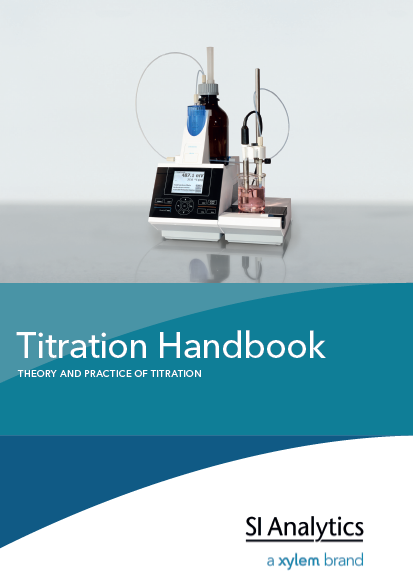 This is an excerpt from the titration handbook. On 192 pages it offers a compact introduction to the theory and practice of titration. If you are interested, you are welcome to download the practical guide as a PDF or request it as a brochure. And in our database you will find numerous applications for your titration for download. A concrete application example of the determination of acid in bases is described in the blogarticle "how to get correct and reproducible results in titration?". Our titration expert answers further questions from our customers in the blog article FAQ on titration.
This is an excerpt from the titration handbook. On 192 pages it offers a compact introduction to the theory and practice of titration. If you are interested, you are welcome to download the practical guide as a PDF or request it as a brochure. And in our database you will find numerous applications for your titration for download. A concrete application example of the determination of acid in bases is described in the blogarticle "how to get correct and reproducible results in titration?". Our titration expert answers further questions from our customers in the blog article FAQ on titration.
Further questions are answered by our expert in the blog article FAQ Titration. Helpful tips for your application area, you can read in our other blog articles: